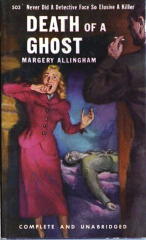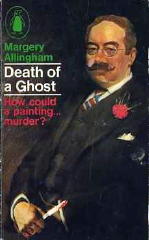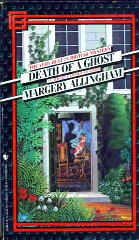Sun 9 Aug 2009
A 1001 MIDNIGHTS review: MARGERY ALLINGHAM – Death of a Ghost.
Posted by Steve under 1001 Midnights , Reviews[6] Comments
by Thomas Baird:
MARGERY ALLINGHAM – Death of a Ghost. Doubleday Crime Club, US, hardcover, 1934. Previously published in the UK by William Heinemann, hc, 1934. Reprinted many times, in both hardcover and paperback, including Penguin #503, pb,1942, in dust jacket; Penguin C379, pb, 6th pr., 1966; Bantam, pb, 5th pr., 1989 (all shown).

Margery Allingham was one of the three major Englishwomen mystery writers of the “Golden Age of Detective Fiction” — the other two, of course, being Agatha Christie and Dorothy L. Sayers.
High literary quality marks her books, some of which have been compared to mainstream novels. Her plots are varied and interesting, portraying such subcultures of the time as the publishing industry, high-fashion houses, the world of the theater, and the life of the aesthete.
Allingham’s plots are not based on razor-sharp surprises, as Christie’s are, but rather are known for their eccentricity. Unlike Sayers, Allingham produced a literate story without precious excesses, without intellectual showing off. Her characters are human, if upper class, and even the minor ones are fully drawn.
Allingham’s consummate creation is the suave sleuth Albert Campion. He comes with a mysterious background of royalty, or at least nobility, but he is “an amateur who never used his real name and title.” Campion confronts international criminal conspiracies, greedy friends and relations, overweening egos turned to madness, and spy threats against his beloved England.

Ultimately, though, Allingham’s best books depend on the investigation and deduction of human motives and psychology for their solutions. Very early tales present Albert Campion as the action-adventurer, popular at that time. In Death of a Ghost, he becomes more the suave dilettante who senses the subtle psychology in suspense situations.
Campion is notable for having no outstanding eccentricities (in contrast to many other Golden Age detectives). He has a vacant face with horn-rimmed spectacles that give him “owlish gravity.” A sign of deep emotion is his taking off his glasses.
In this novel the plot concerns an odd will left by an artist who died years before. The artist, John Lafeadio, considered himself the foremost painter of his age. He left behind a tangled menage of wife, Belle; family; and sycophants. The will provides that each year a painting be taken from a secret cache and exhibited at an exclusive art show in order to maintain Lafcadio’s artistic immortality.

During the current exhibit, the lights fail, and when they’re turned back on, another painter is found a corpse. A short time later, another minor member of the menage is also killed.
Campion wades through the art group’s murky crosscurrents of emotion and suspicion, exploring alibis and evasions. The police are represented by Inspector Stanislaus Oates, “the shrewdest and at the same time most kindly member of the Yard.”
Official and amateur come to agree on the killer, but getting the proof means Campion must face a final, ingenious attempt on his own life.
———
Reprinted with permission from 1001 Midnights, edited by Bill Pronzini & Marcia Muller and published by The Battered Silicon Dispatch Box, 2007. Copyright © 1986, 2007 by the Pronzini-Muller Family Trust.
August 9th, 2009 at 9:10 pm
I have a question. I do not know whether the gentleman you see in the second cover down is supposed to be Albert Campion or not, but if it is, he’s far from my mental picture of him.
I suppose I might have been influenced by the second series of TV mysteries adapted by the BBC, but my idea of what Campion looks like is a lot like Peter Davison, who also played Dangerous Davies as well as one of the Doctor Who’s in a long line of actors who’ve played the part:
But here’s the thing. This is what I thought Mr. Campion looked like even before the BBC came along, which wasn’t until the late 1980s. How about you?
August 10th, 2009 at 1:02 am
I think that is supposed to be a painting of the painter in the story, though the glasses do confuse things. I’m not sure that would be anyone’s idea of Campion, or was intended to be.
Davison was very good as Campion, though I found him a bit better looking than my idea of the character who I always suspected was meant to look a bit like the Duke of Windsor with glasses and less flashy clothes, or perhaps his less spectacular brother.
Allingham’s descriptions of the character are more about what you don’t see than what you do, the most common word in his description being ‘vacant.’ I’m not sure I ever had an actor in mind for the role until I saw Davison, who seemed to fit the part quite well. On the other hand, the actor playing Lugg was exactly as I pictured him.
For that matter, Ian Carmichael was both too old and too chubby to play Lord Peter Wimsey, and yet I can’t see anyone else in the role today.
August 10th, 2009 at 11:14 am
Actually, I read once that when Allingham first created Albert Campion she said he was based on the Prince of Wales who eventually was the Duke of Windsor.
August 10th, 2009 at 12:16 pm
“Vacant”? I’d nominate David Hyde Pierce for the role.
August 10th, 2009 at 12:29 pm
I’ve come across references along the same line, Ray, which is probably where you, David, also got the idea he looked like the Prince of Wales/Duke of Windsor.
That almost assuredly eliminates the gentleman on the cover as being Campion, unless we grant the artist more license that he ought to have. That mustache is quite magnificent, but on Campion? I probably shouldn’t even have brought it up!
— Steve
PS. To egm3, whose comment re David Hyde Pierce came in while I was writing this one, yes, I can see him as Campion well enough, once I get past his comedy persona. I missed the Peter Davison adaptations, I’m sorry to say, and I’ll have to do something about that soon.
August 10th, 2009 at 3:48 pm
I thought some of the Davison Campions were quite good. They got better as they went along, it’s a shame they didn’t have a third season, with Fashion in Shrouds, Traitor’s Purse, Coroner’s Pidgeon and More Work for the Undertaker.